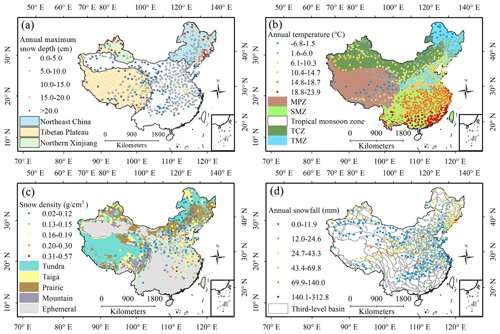Researchers estimate trends and variability of snowmelt in China

Snowmelt is an important fresh water resource, with more than one-sixth of the world's population relying on it for water. In the arid areas of northwest China, snowmelt runoff accounts for about 20~70% of runoff.
Climate warming changes the snowfall/rainfall ratio, snowmelt time and speed, influencing the volume as well as the distribution of annual runoff. However, at present, the spatial-temporal change of snowmelt and its response to climate change are not clear yet.
Using a high-spatial-resolution data set of monthly air temperatures and precipitation, researchers from the Northwest Institute of Eco-Environment and Resources of the Chinese Academy of Sciences (CAS) constructed a large-scale snowmelt model to calculate the monthly and annual snowmelt in China from 1951 to 2017.
Related results were published in Hydrology and Earth System Sciences.
The researchers used precipitation and temperature scenarios developed from five CMIP5 models to predict future snowmelt in China under three different representative concentration pathway (RCP) scenarios (RCP2.6, RCP4.5 and RCP8.5).
They found that the mean annual snowmelt in China from 1951 to 2017 was 2.41×1011m3yr-1, of which the three main stable snow cover regions in Northern Xinjiang, Northeast China and the Qinghai-Tibet Plateau were 0.18×1011, 0.42×1011 and 1.15×1011m3yr-1, respectively.
From 1951 to 2017, the annual snowmelt runoff ratios showed a decreasing trend in most third-level basins in China. However, snowmelt showed an increasing trend in the Qinghai-Tibet Plateau, and it increased significantly in Northern Xinjiang and Northeast China in recent 10 years.
Under RCP2.6, RCP4.5 and RCP8.5, the projected snowmelt in China in the near future (2011–2040; mid-future 2041–2070; far future 2071–2099) may decrease by 10.4% (15.8%; 13.9%), 12.0% (17.9%; 21.1%) and 11.7% (24.8%; 36.5%) compared to the reference period (1981–2010), respectively.
This study is the first attempt to quantify snowmelt and its changes in China, which may have important implications for future research on snow-hydrology-climate interactions and contribute to water resource management planning under climate change.
More information: Yong Yang et al, Trends and variability in snowmelt in China under climate change, Hydrology and Earth System Sciences (2022). DOI: 10.5194/hess-26-305-2022
Provided by Chinese Academy of Sciences


















